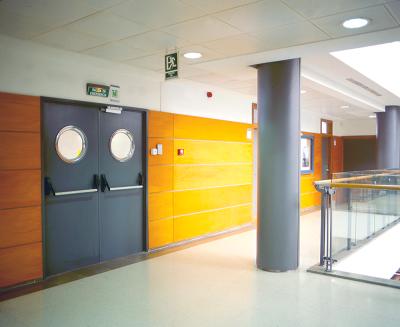

Automatic doors gain protagonism in comprehensive security

Automatic doors play an increasingly important role in the comprehensive safety and security of buildings, shops, companies, and homes. Fire doors isolate the area where a fire has broken out, thereby stopping its spread; armored security doors withstand any attack and safeguard possessions; and access controls facilitate identification and entry of people and vehicles.
Security involves an overall multidisciplinary analysis of the risks we want to prevent, as Montserrat Iglesias-Lucía, Director of the School of Prevention and Comprehensive Security at the Universidad Autónoma de Barcelona (UAB) explains. And to increase its efficiency, we have to take into account different variables, including "the protocols for actuation, the design of the spaces and physical protection elements such as doors and access mechanisms".
In addition, the Spanish Association of Security Companies (AES) warns that, in the case of pedestrian doors, they must have "every device and sensor needed to ensure safe use and prevent accidents that can cause becoming trapped, being struck, or any kind of lesion to the people who use them". To reinforce this aspect, "their installation must be done following regulatory requirements", and the owner is obliged to carry out "maintenance work as necessary".
Jose Vicente Andreu, an expert on fire doors at TECHNIFUEGO, the Spanish Association of Fire Protection Companies, adds that "to ensure that a door maintains the features it was designed for, it must be able to close when it is supposed to block passage, and to open when it is supposed to facilitate it. And this should be done automatically and suitably controlled".
Types of protection
Iglesias-Lucía (UAB) notes that there are different modalities of doors and access mechanisms that help ward off the threat we want to prevent. "For example, fire doors isolate the area where a fire has broken out, preventing or slowing its spread and preventing people being evacuated from entering that area during the evacuation process".
In contrast, "access controls facilitate identification and permission, if applicable, to authorized people and/or vehicles, which lowers the risk of others entering who may pose a danger to our organization". Moreover, "the possibility of long-distance identifications prevents the use of devices that can be manipulated". And finally, "armored security doors let us withstand violent attacks, safeguarding, preventing, or hindering access to the goods we want to protect".
The Spanish Association of Security Companies (AES) especially highlights access control enabled by the use of devices for opening and closing automatic doors. "Not only is it possible to decide who we want to be able to enter, but also the timetable (days and times) when said access is authorized.. Moreover, all the entrances and exits can be registered for supervision and control purposes; as well as documenting attempted entries outside the authorized schedule".
As regards the structure of the doors, "we can increase security from attempts at unauthorized entry by improving their resistance to break-ins (testing their resistance to dynamic and static loads, and to manual attacks); as well as to other types of risks such as the spread of fire between fire sectors (a feature that can also be tested).
José Vicente Andreu (TECHNIFUEGO) affirms that the doors are a fundamental element that contributes to making buildings safer, more secure and inhabitable. Some of the features they can provide are the following: "fire protection, fire resistance, smoke control, safety for evacuation, safety from intrusion, protection against noise, energy saving and leaktightness". He concludes that "only automatic doors (whether motor-driven or not) can ensure compliance with their function for the safety and habitability of the building and to do it safely, with no risk to people or goods".




